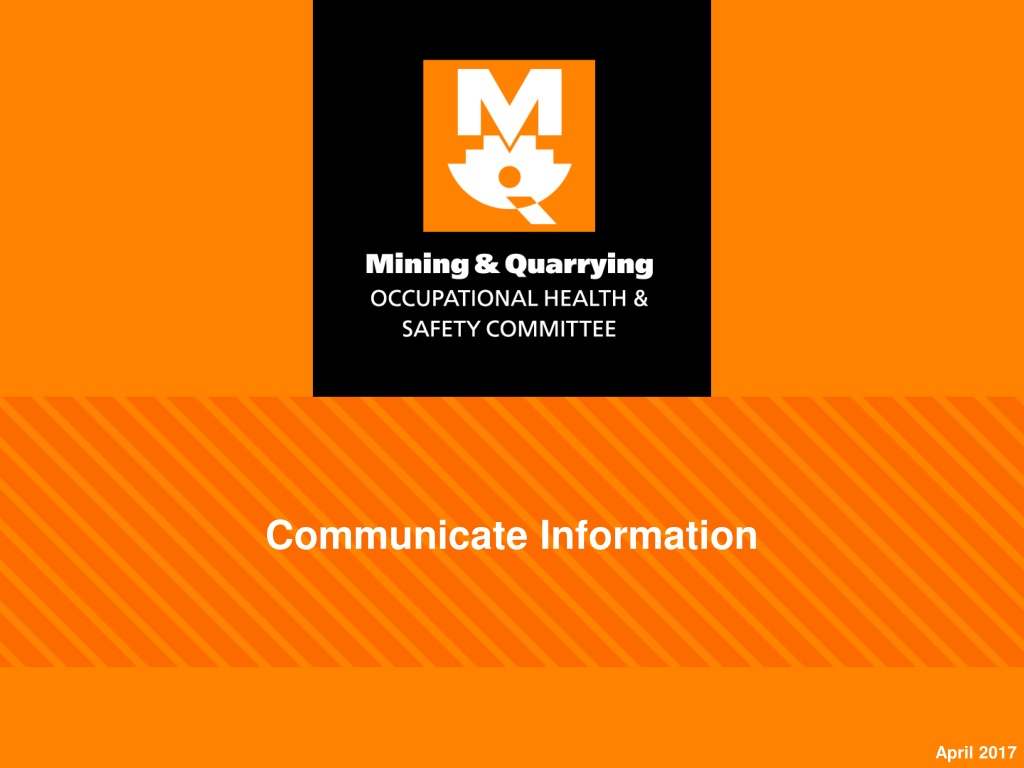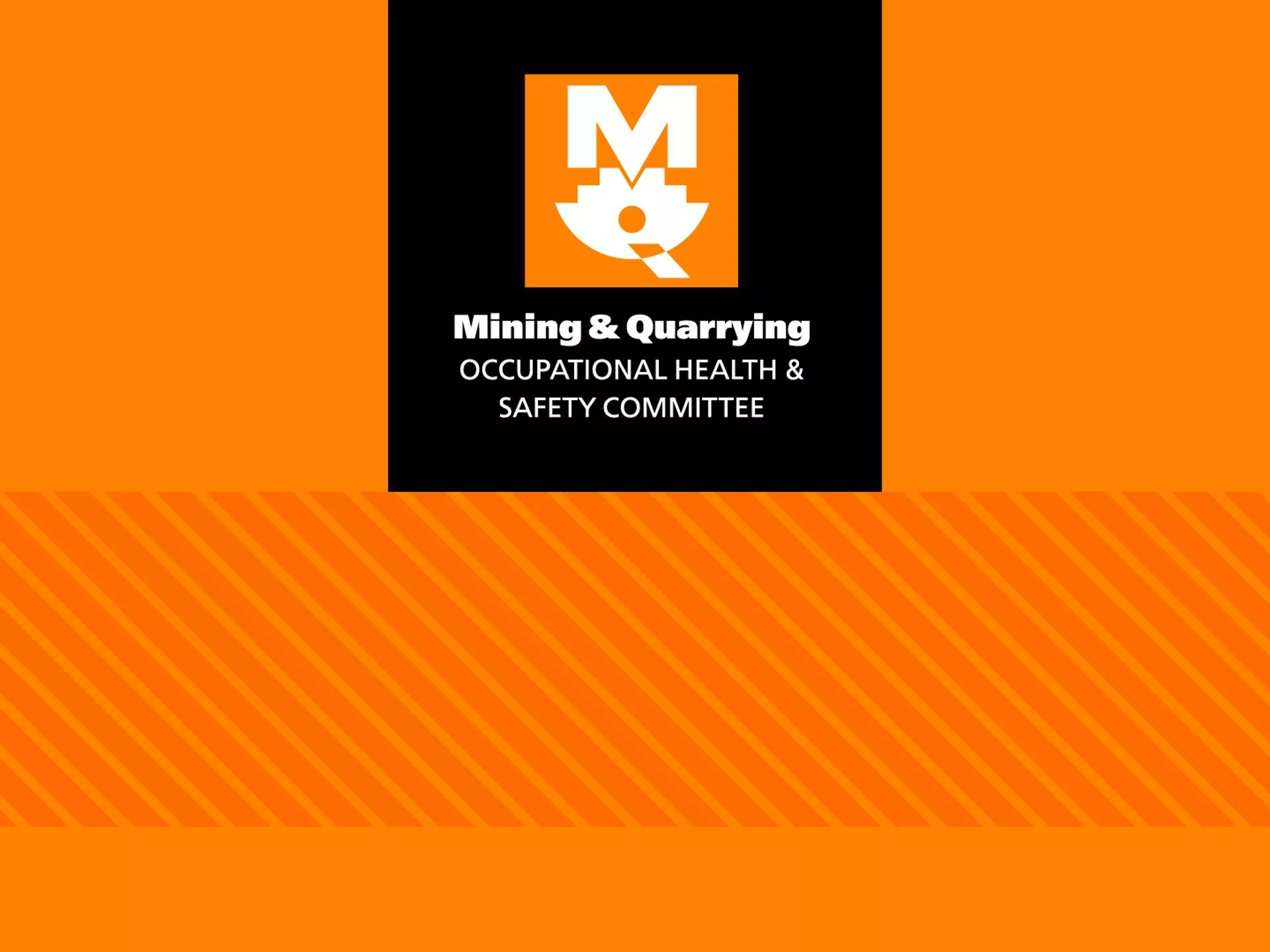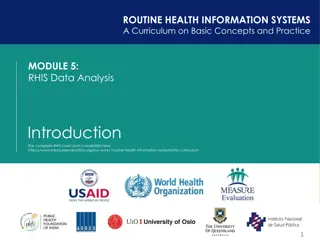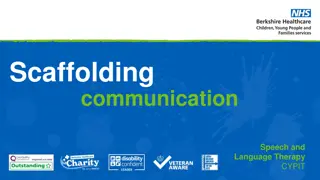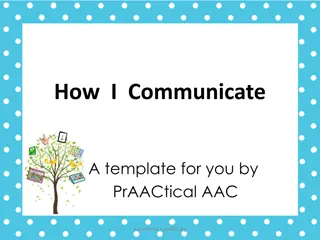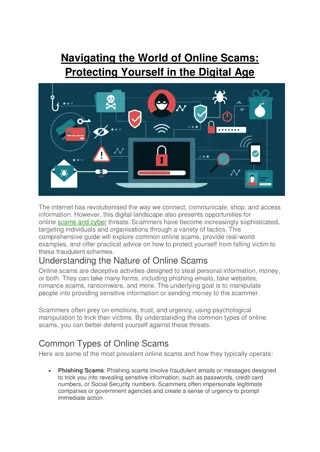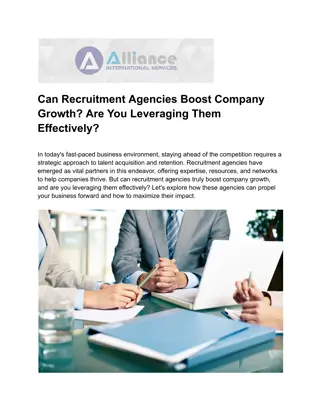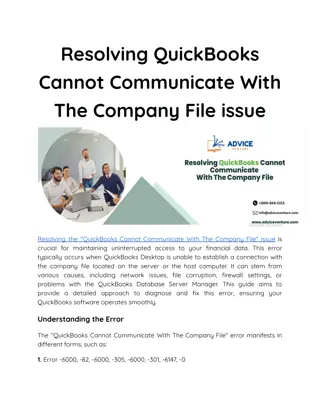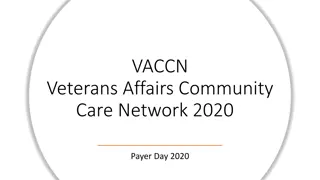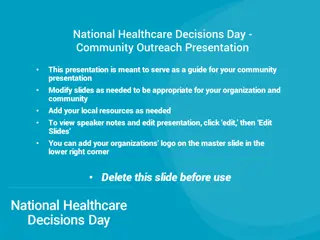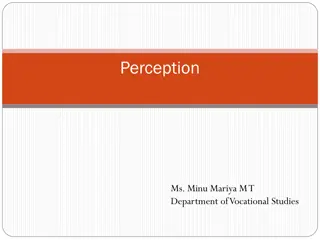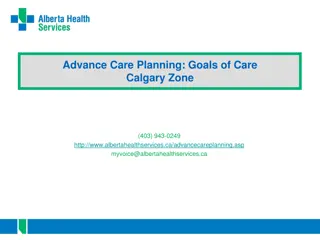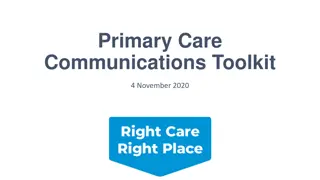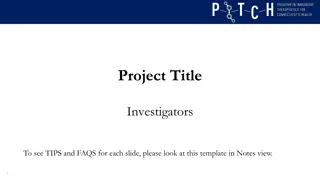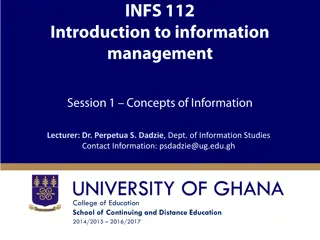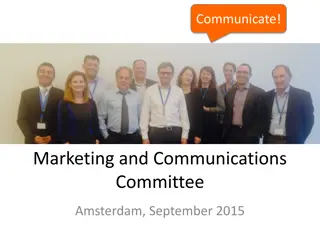Communicate Information
The Mining and Quarrying Occupational Health and Safety Committee provides valuable insights into promoting work health and safety in the workplace. The presentation covers effective communication methods, safety measures, and the importance of maintaining a secure work environment. Explore the various ways information is communicated across sites, such as noticeboards, meetings, and reports. Understand the essence of communication and how it influences interactions between individuals. Gain knowledge on achieving meeting outcomes, delivering presentations, and engaging in negotiations to enhance workplace communication practices.
Download Presentation

Please find below an Image/Link to download the presentation.
The content on the website is provided AS IS for your information and personal use only. It may not be sold, licensed, or shared on other websites without obtaining consent from the author.If you encounter any issues during the download, it is possible that the publisher has removed the file from their server.
You are allowed to download the files provided on this website for personal or commercial use, subject to the condition that they are used lawfully. All files are the property of their respective owners.
The content on the website is provided AS IS for your information and personal use only. It may not be sold, licensed, or shared on other websites without obtaining consent from the author.
E N D
Presentation Transcript
Communicate Information April 2017
The Mining and Quarrying Occupational Health and Safety Committee Promoting Work Health and Safety in the Workplace This workplace industry safety presentation is developed and fully funded by the Mining and Quarrying Occupational Health and Safety Committee (MAQOHSC). ISBN 978-1-925361-37-7 2
Disclaimer IMPORTANT: The information in this presentation is of a general nature, and should not be relied upon as individual professional advice. If necessary, legal advice should be obtained from a legal practitioner with expertise in the field of Work Health and Safety law (SA). Although every effort has been made to ensure that the information in this presentation is complete, current and accurate, the Mining and Quarrying Occupational Health and Safety Committee, any agent, author, contributor or the South Australian Government, does not guarantee that it is so, and the Committee accepts no responsibility for any loss, damage or personal injury that may result from the use of any material which is not complete, current and accurate. Users should always verify historical material by making and relying upon their own separate inquiries prior to making any important decisions or taking any action on the basis of this information. 3
Creative Commons This work is licenced under Creative Commons Attribution Non Commercial 4.0 International Licence. The licence is available to view at http://creativecommons.org/licenses/by-nc/4.0/ This creative commons licence allows you to copy, communicate and or adapt our work for non-commercial purposes only, as long as you attribute the work to Mining and Quarrying Occupational Health and Safety Committee and abide by all the other licence terms therein. 4
Learning Outcomes Communicate effectively orally and written Achieve meeting outcomes Deliver a presentation Participate in a negotiation. 5
How is information communicated across site? Noticeboards Management meetings Reports Pre-shift meetings. 6
What is Communication? Communication is any behaviour, verbal or non - verbal, that is perceived by another. Listening Effective communication is giving and receiving information in a way that is clear and easily understood by both the sender and the receiver. Information Reading Observing 7
Communication Process C H A N N E L Idea Encode Transmit Receive Decode Some idea Sender Receiver Barriers Feedback 8
Communication involves Speech (Verbal) Passing information Writing Non Verbal 9
Benefits of Effective Communication Employees feel that they belong and are involved in the workplace Promotes commitment Enhances morale Saves time and effort (fewer mistakes) Increased cost effectiveness Safer working environment Able to work as a team. 10
Barriers to Effective Communication Listening only to words Fear of being influenced Selective listening Barriers Selective memory Poor timing Personal Bias Expectation 11
Components of Communication Verbal the actual words used, including their meanings and connotations, and the way the words are put together. e.g. format and logic of the message. Vocals use of voice to deliver the message. e.g. volume, pitch, tone, speed, inflection, pronunciation, and the use of pauses and silence. 12
Non Verbal Communication Body language Physical characteristics Touching behaviour Vocal qualities tone, pitch Personal space Artefacts Environment. 13
3 Vs - Vocal, Verbal and Visual 7% - 38% - 55% Rule In his studies, Mehrabian (1971) comes to two conclusions. Firstly, that there are basically three elements in any face-to-face communication: Words Tone of voice Body language. These three elements account differently for our liking for the person who puts forward the message: words account for 7%, tone of voice accounts for 38% and body language accounts for 55% of the liking. 14
3 Vs - Vocal, Verbal and Visual 7% - 38% - 55% Rule continued For effective and meaningful communication about emotions, these three parts of the message need to support each other - they have to be congruent. The following example should help illustrate incongruence in verbal and non-verbal communication: Verbal: "I do not have a problem with you!" Non-verbal: person avoids eye-contact, looks anxious, has a closed body language, etc. 15
Perception Perception is the way people understand or give meaning to their environment. Perception and interpretation of the same message may vary between people. This is because individual perception is influenced by experience, attitudes and beliefs and a range of acquired skills or expectations. 16
Listening vs Hearing There is a difference between hearing and listening. Hearing is a physical process. Listening refers to the interpretive process that takes place with what we hear. Listening involves both hearing and striving to understand the other person s message. If you listen well, you will understand the feelings and the content in the message. If you are distracted, much of the message s content and meaning will be lost. 17
Why is listening important? We need to know what is expected of us It ensures tasks are completed as required It shows courtesy / respect for the sender We can learn from listening If we listen to the sender, then they are more likely to listen to us It encourages further communication It allows us to select an appropriate response or feedback It allows the correct task to be conducted appropriately. 18
A Guide to Better Listening Listen for the whole message Watch for non-verbal signals Concentrate Resist distractions Avoid premature judgments Keep your objectivity Be patient listen - let speaker finish before formulating response Ask questions to check understanding Use appropriate body language lean forward, nod, mirror body language. 19
Sending Clear Messages Check current knowledge Have a positive attitude Be enthusiastic Simple, clear language at a moderate pace Use appropriate body language facial expressions, eye contact Be careful with tone of voice Demonstrate Set the scene Explain thoroughly Check understanding. 20
Questions Types of questions may include the following: Open Closed Targeted Probing Hypothetical. 21
Open Questions These questions encourage the speaker to give more information. They generally start with who, what, where, when, why and how. They are more likely to lead to a more detailed and thorough response. Examples: Tell me about the incident? Why did you empty the paint thinner down the sink? How do you think this works? Explain the task to me. 22
Closed Questions These questions are useful for finding out specifics, but generally require a limited response (yes or no). They close the speaker from answering the question more fully, and give the asker limited information. Examples: Do you understand what I am saying? Did you see the incident occur? Can I have your credit card to go shopping? 23
Targeted Questions These questions are very useful to use when you have a reserved group or a group with a couple of dominant personalities hijacking your meetings. Targeted questions are preceded by the name of the person from whom you want an answer. e.g. James, can you tell me the characteristics of great leaders? 24
Probing Questions These questions are useful to check finer points of participants assumptions, opinions, facts or plans. They build on information already received but seek further information. Examples: What makes you say that? Why would you do it that way? 25
Hypothetical Questions These questions are used to encourage creativity and thinking outside the box. They are excellent for generating ideas and for addressing contingency situations. Examples: What would you do if Max amputated his hand whilst using the drop saw in the workshop? How would you manage an emergency in the pit? How would you convince your partner not to get her engagement ring valued knowing that the huge diamond you purchased for her is really cubic zirconia? 26
Improving Verbal Communication Use eye contact Adjust voice level so all can hear Speak clearly Avoid monotone Speak more slowly than normal Allow for questions and answers Check understanding by asking questions. 27
Styles of Communication Aggressive Submissive Assertive. 28
Aggressive people Demand their rights, and deny the rights of others Attack the person, not the problem Get angry, make threats and ridicule Are often loud, abusive and sarcastic Want to get their own way Want win / lose solutions. 29
Submissive people Deny their own rights Are emotionally dishonest Communicate indirectly Feel hurt, anxious and insecure Often get lose / win solutions. 30
Assertiveness is standing up for your basic human rights without infringing on the rights of others. 31
Assertive people Express their true feelings, communicating honestly and directly Acknowledge their rights and the rights of others Are self confident, polite and persistent Look for win / win solutions to problems. Assertiveness is linked to self esteem and is considered an important communication skill. A person communicates assertively by not being afraid to speak his or her mind or trying to influence others, but doing so in a way that respects the personal boundaries of others. They are also willing to defend themselves against aggressive incursions. 32
Workplace Scenario Your supervisor approaches you to work overtime this weekend. However, you have already made plans to watch your child play in his sporting grand final. Your supervisor explains that to meet a client request, an urgent job needs to be completed this weekend. You are his best worker and he really needs you to work this weekend. Will you work? 33
Negotiation Negotiation is the process of securing an agreement between parties with different needs and goals. Negotiation is a basic human activity. All employees, including middle managers and senior executives are called upon to negotiate, almost on a daily basis. More often than not, however, this is done intuitively or on an ad-hoc basis rather than by following a planned, proven strategy. Negotiation is a planned sequence of events that requires strategy, sound interpersonal skills, emotional intelligence and patience. Preparation is probably the single most important part of successful negotiations. 34
Successful Negotiation Successful negotiators have a positive vision of their success. They fully understand their subject matter and have a firm grasp of the negotiation process. In addition, they can also read people very well. Accomplished negotiators know not only their own personal negotiation style, but also their counterpart s preferred negotiation style - and they use this knowledge to build a stronger relationship that will help achieve their goals. 35
Negotiation Strategies Win / lose Win / win Lose / win Lose / lose. 36
Written Communication Meeting minutes Forms and documentation Memos Statistics Letters Reports annual, end of month Job hazard analysis / Risk assessments Emails Procedures Posters Newsletters Incident reports 37
Written Communication The use of plain English when writing will help you communicate your message effectively and efficiently. Technical writing is difficult to understand. Many writers use complex words and sentence constructions. While this might make the writer feel important and knowledgeable, it only confuses readers. It is not reasonable to think that the words you use mean the same thing to your readers as they do to you. Unless the message is in plain English, the consequences can be confusion, misunderstandings, inefficiency and work having to be redone. 38
Written Communication 7 characteristics of effective written communications are: 1. Clear readable, logical and unambiguous 2. Complete contains all necessary details 3. Concise has no more detail than is necessary 4. Considerate aware of the reader 5. Courteous tactful and sensitive 6. Concrete not vague or abstract 7. Correct in details, grammar and spelling 39
Assertiveness The seven characteristics of effective written communications are achieved through appropriate use of six components of writing style: The words (language) you use The sentences you write The paragraphs you construct The rhythm or flow you achieve The tone you adopt The layout or format of your document. 40
Language Use simple language Remove unnecessary words Choose concrete language Avoid technical jargon Choose non discriminatory and inclusive language no racial or religious jokes, no sexist comments. 41
Sentences and Paragraphs Simple sentences one idea per sentence Short sentences Punctuation Spell check Acronyms and abbreviations Paragraphs group a set of ideas Paragraphs should have at least 2 sentences Separate paragraphs by a double line spacing. 42
Review the written communication Check written communication prior to sending to ensure: Accuracy Clear purpose for receiver It is well set out It is easy to read It conveys your ideas as you intended The tone is appropriate It is being sent to correct person Contact details are provided. 43
How Many Fs The soldiers of the first fleet were brave and fearless as they fought all of the forces of nature when facing the fierce storm off the coast of Australia. The soldiers of the first fleet were brave and fearless as they fought all of the forces of nature when facing the fierce storm off the coast of Australia. 13 F s 44
Summary We have discussed: The communication process Verbal communication Non-verbal communication Written communication Negotiation Feedback. Any questions? 45
Further Assistance MAQOHSC Work Health and Safety Specialists are available to provide further on-site support and assistance on all Work Health and Safety matters. MAQOHSC Work Health and Safety Specialists can be contacted via our online support request form available on our website at www.maqohsc.sa.gov.au or email maqohsc@sa.gov.au. Work Health and Safety Legislation, Codes of Practice, fact sheets, Health and Safety Representatives (HSR) information and guides can be found at the following websites: SafeWork SA www.safework.sa.gov.au or call 1300 365 255 Safe Work Australia www.safeworkaustralia.gov.au or call 1300 551 832 46
